Summary: The present-day market scenarios require organizations to operate with new capabilities that enhance overall performance, revenue, and customer base. Successful organizations must become more open to evolution at all levels – teams, structures, and technology. Agile transformation, therefore, is an essential component and failure to follow more often than not, leads to the loss in terms of work processes, product quality, and revenues. But what are the challenges to this transformation? And why do agile transformations fail? Below we look at the top reasons for failure and how you can succeed.
Agile is all about ‘iterations.’ In the process of software development, it implies creating products with increments & iterations – also called ‘Sprints.’ Based on a pragmatic approach to product development, it enhances the product quality and aids the teams in focusing on users and core business.
The Agile Manifesto lists the following as the basic principles:
- Individuals and interactions over processes and tools
- Working software over comprehensive documentation
- Customer collaboration over contract negotiation
- Responding to change by following a plan
The agile transformation will include an organization’s total metamorphosis – the journey implies moving from bureaucratic structures to more adaptable ones. It also means creating environments of innovation & flexibility along with speed in working. Employee empowerment is a vital ingredient to this recipe for agility.
Adopting agile habits means working on the practices, processes, frameworks, etc. The product and software teams can achieve this through frequent collaboration, feedback, and product release. The transformation will include large-scale organizational changes – strategy, structure, processes, people, and technology. Adoption can improve value delivery, flexibility, and quality, and transformation works on the structure & decision-making processes. You could always turn to and depend on an efficient agile scrum development company for the digital services it offers to help you with the agile transformation and software solutions.
Over two decades since the Agile Manifesto, 50-96% of agile transformation processes fail because of an inability to rapidly adapt to market and environmental changes in a productive and cost-efficient manner. That’s an alarming agile transformation failure rate indeed!
There could be many reasons why agile transformations fail, and here are some more prominent ones that come up as challenges for organizations on their agile journey.
10 Agile Transformation Challenges
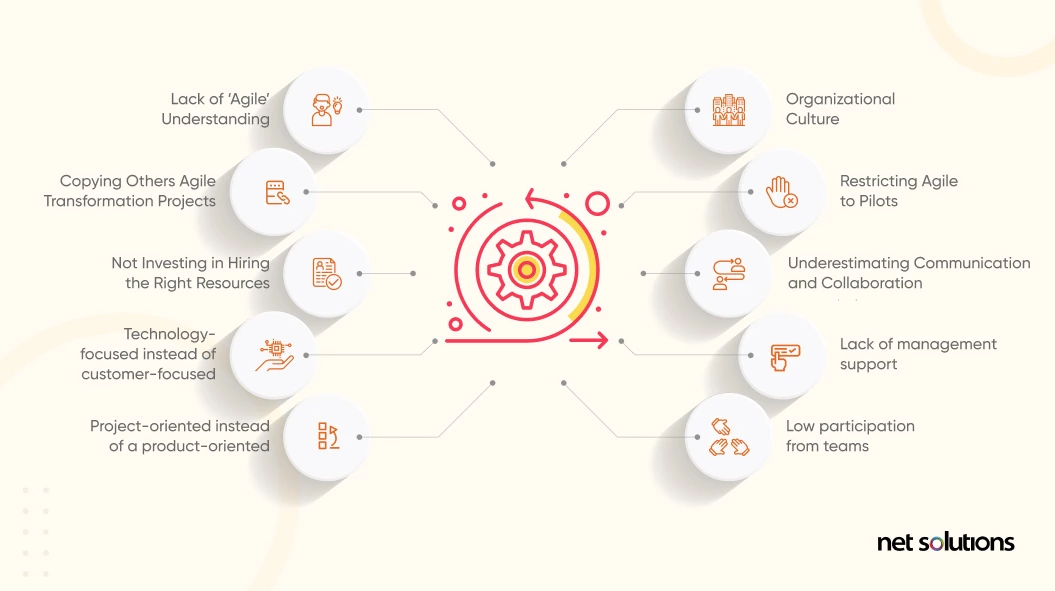
The 15th Annual-State-Of-Agile-Report by digital.ai states that most organizations initiate agile transformations for the following reasons:
- Enhance ability to manage priorities
- Accelerate software delivery
- Increase team productivity
- Improve business and IT alignment
- Enhance software quality
- Improve delivery predictability
- Better manage distributed teams
It also lists a variety of challenges that companies face while adopting Agile product development. Common challenges are process inconsistency, cultural clashes, organizational resistance, and lack of skills and experience, which have been broadly unchanged over the years. Below we take a look at the significant heads:
1. Lack of ‘Agile’ Understanding
Agile Manifesto deals with software development, not business outcomes. On the other hand, organizational agility is the capability to adapt to changing market conditions, which was never the objective.
CTOs prefer to look for ways to build the right products faster and get to market more quickly. They start to transform their engineering teams to become more efficient, and they apply this work order to their product development process and claim that an agile transformation is in play. A focus on transformation in product development is an important reason why agile transformations fail.

We respect your privacy. Your information is safe.
2. Organizational Culture
Mindset plays an essential part in defining organizational culture. Each corporate culture is driven by a shared perspective, evaluation paradigms, and behavioral patterns. One of the significant setbacks, whenever a change is brought into an organization, is the people’s resistance and ignoring the cultural and change-management implications of agile.
Going agile is a radical organizational change, which means breaking down the traditional silos mentality. It means cutting through all types of change – breaking old habits in the organization and adopting new ways of working.
Organizations with a solid command-and-control culture often overlook it as a challenge. They wish agile fits their organizational culture, which is why agile transformations fail. Organizations need to avoid shifting the entire culture in one sweep. Appropriate support from all levels and solutions based on the skill set of the teams will help. Organizational needs, long-term business vision, and team capabilities shape your pyramid of success.
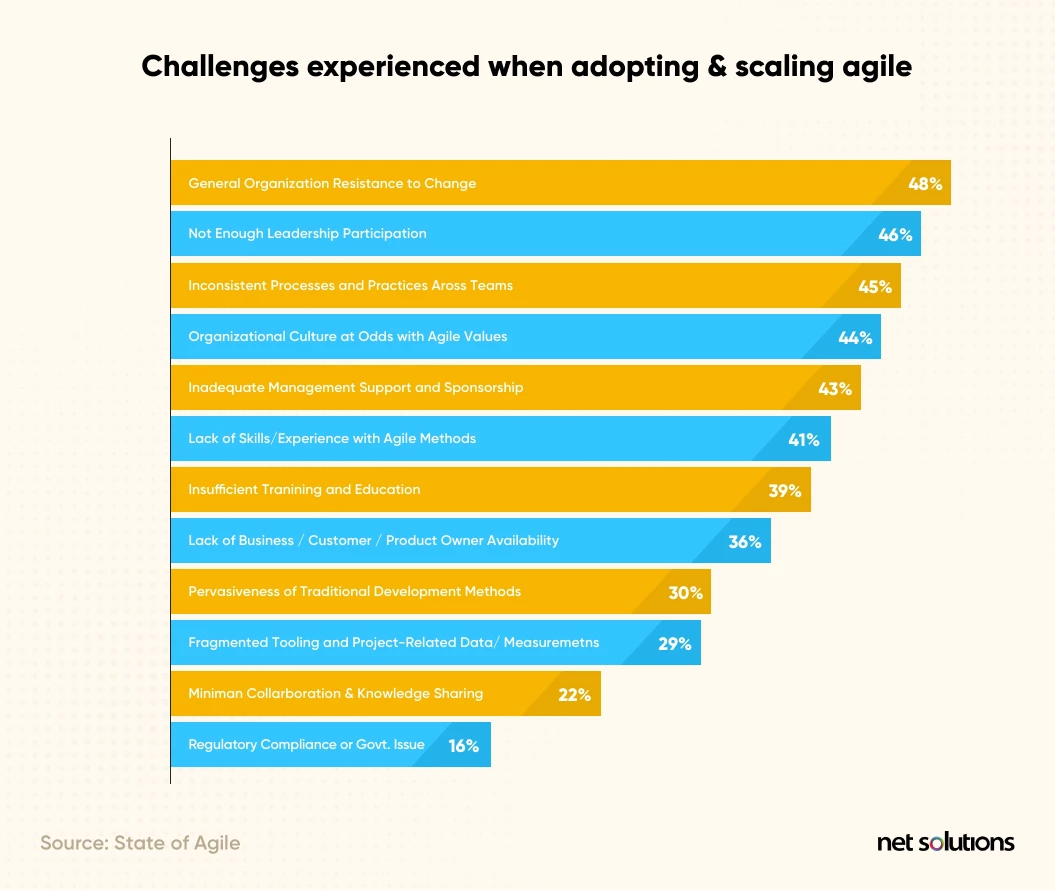
Agile transformation is a radical change in small and large organizations. Moving away from historically evolved and manifested mindsets toward an ideal cultural setup is essential to transforming your organization. The organization should establish and promote this set-up on a top-down basis, in the context of the organization’s strengths and weaknesses.
You cannot force employees of your organization to enjoy agile working methods. Build a corporate culture based on trust, team spirit, and commitment, and employees will start to embrace agile work methods resulting in agile product development.
3. Copying Others Agile Transformation Projects
One reason agile transformations fail is that organizations fall into the trap of copying another organization’s process. How are most of the agile transformation projects currently being implemented?
In most cases, someone (agile coach) is hired from outside the organization. They define your agile transformation roadmap by bringing in a specific, already used set of practices that, according to them, are best for you. Or someone from the organization will get inspired by the ING case study or a Spotify video and use that as a blueprint for transformation instead of a manual. That is one of the significant reasons why agile transformations fail.
Copying what other organizations did and using it as a cargo cult is a wrong approach that leads to agile methodology failures. Your organization will have different requirements and priorities than those organizations you are copying from.
Agile project management is about thinking, running small experiments, and improving quickly and easily. An agile organization always keeps exercising and building the muscle of learning. You should build your internal coaches who can help you lead your organization’s transformation from the inside out. You will undoubtedly require the help of an external digital experience agency to kick-start the transformation. Still, your employees need to own it, which includes making informed decisions about the transformation.
4. Restricting Agile to Pilots
Agile transformations often fail due to organizations limiting them to pilot projects and waiting for results. The pilot project’s restricted nature prevents the C-level executives from seeing the impacts a broader agile transformation could have.
While starting the agile transformation within a small organization team is acceptable, it is crucial not to stop there and wait for outcomes. Agile teams must approach it holistically and embed agile principles in their culture throughout the organization. Spreading agile beyond small groups is where the real advantages arise.
5. Not Investing in Hiring the Right Resources
One of the agile principles is building self-organizing teams, which requires hiring motivated and skilled individuals. The proper human resources are the fuel that supports the agile journey of organizations. However, inadequate training and talent are often the most prominent reasons agile transformations fail. According to Net Solutions’ Agile Product Development Report, 66.2% of surveyed team leaders said their team members do not entirely understand agile and what value it delivers. Successful agile transformation is impossible without team members knowing the importance of agile.
While every organization should develop a strict process for hiring the right talent, the agile team can not just compromise when bringing people on board. Agile is against micromanaging; therefore, you need to hire people who can manage themselves and create value for the business.
Here are some tips you should follow before you start hiring people for your agile team:
- Focus on people, not just on skills. Agile teams need individuals with the right personality, mindset, and values.
- Find the intrinsic skills needed to succeed in agile projects and where you can find such resources.
- Don’t compromise ever – you may feel the need to hire someone immediately. However, product owners shouldn’t do that.
6. Underestimating Communication and Collaboration
A lopsided and underutilized methodology of communication and collaboration is often why agile transformations fail. Improper communication and collaboration are significant hurdles in larger teams.
Agile software development favors individuals & interactions over processes & tools. However, adhering to this principle in a large organization or distributed agile teams often becomes challenging.
In agile development methodology, where short iterations are preferred, effective collaboration and communication become a significant problem. Not solving this problem effectively is an important reason why agile transformations fail.
Following agile principles, it is crucial to have everyone involved in the project. Agile teams should have a proper balance of time devoted to collaboration and other development activities. They must have pre-scheduled meetings and focus on user stories. Besides, they must engage with each other over small talks online to know each other better.
Here are some more strategies that will help the agile teams working in a distributed environment:
- Use video conferencing tools for project meetings
- Use digital whiteboards for design sessions and sprint planning
- Use low-code apps or surveys to gather feedback in retrospective
The agile transformation journey is a bit challenging. However, by avoiding the common agile transformation pitfalls like failing to set a framework that doesn’t support agile principles and not putting the culture first, you can surely build an agile team that creates value.
Here are the top 5 Agile techniques to ensure better communication and working as per the 14th state of agile report respondents:
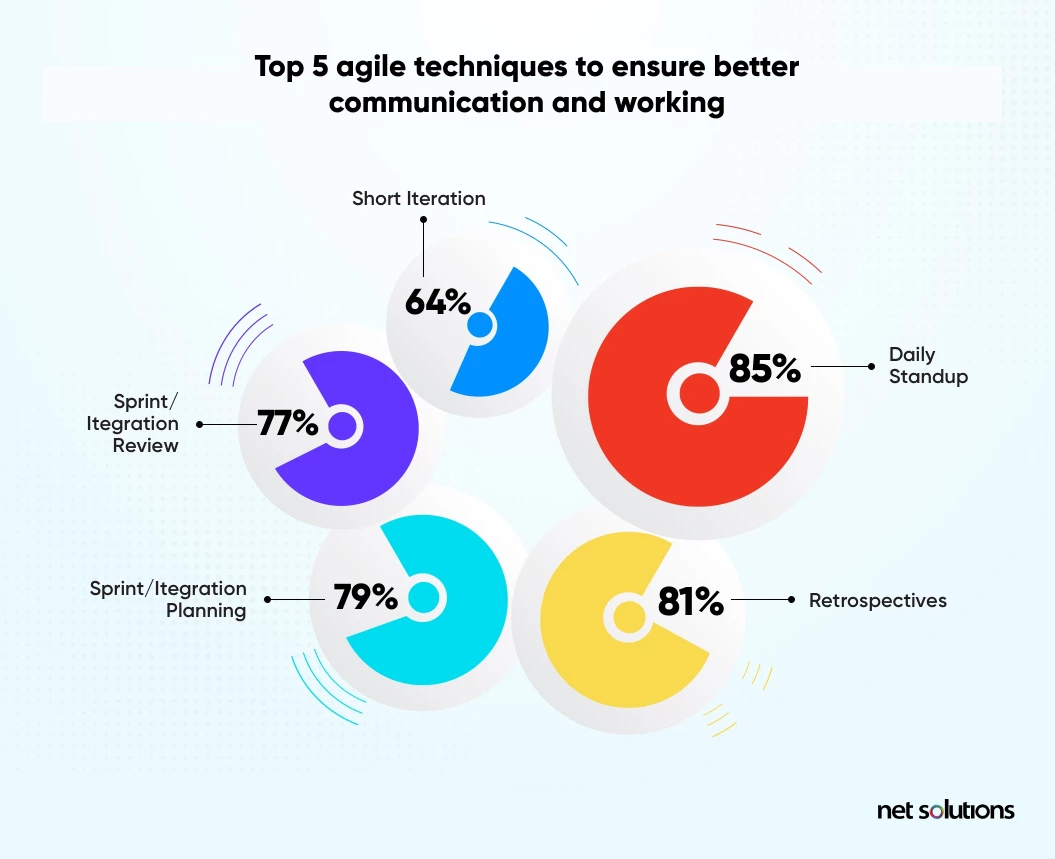
Also, finding an answer to why you need agility is crucial to agile transformation success. Often, product managers or owners give vague reasons like they want to market the product faster or be agile like other teams, leading to discrepancies. These are not valid reasons to pursue an agile transformation. Keep in mind that well-defined reasons will cause your agile transformation to be more valuable and successful.
7. Technology-focused instead of customer-focused
Agile transformation demands that the concerned teams focus on the customers and the deliverables. Instead, organizations sometimes focus too much on productivity and technology, which is why agile transformations fail. Since the focus is vague, products don’t get adequately defined. Organizations act as barriers to team interaction with the customers. This leads to a lack of understanding of user needs, market responses, and a holistic approach to the customer psyche. No awareness means no impetus to innovate and no initiative to experiment or learn.
8. Lack of management support
A lack of management support is a primary reason why agile transformations fail. One part of the success involves finding the right collaboration partner to take care of the agile transformation process. An organization needs teams working closely with the management on the process – discussing the processes, benefits, and drawbacks. The transformational initiatives should come from the top-down so that there is full awareness and involvement from the senior management levels. When this happens, a planned data collection system can take care of the agile transformation process. Sometimes external pressures and lack of support from external stakeholders are also why agile transformations fail.
9. Project-oriented instead of a product-oriented
Agile transformations can fail if an organization focuses on achieving project targets without defining products properly. Conventional project management approaches persist, and there is a fixation on some fixed time, scope, and budget and, therefore, not much of an opportunity to adapt or focus on the appropriate deliverables. Imbalance in measuring progress also causes failures, and the limited mindset is why agile transformations fail.
10. Low participation from teams
Employee definitions of what the organization is missing and where it needs fixing can vary; sometimes, they just don’t buy the concept. Mental blocks or a bias towards trying anything new – plain defiance of change; any of these things could become reasons why agile transformations fail. A shift in philosophy is not something everyone can relate to or accept easily.
Now that you have a reasonably good idea of why agile transformations fail, what would you do to ensure that your organizational process is successful?
5 Tips to fix Agile transformation failure
There are certain fundamental organizational culture aspects that you will need to focus on if you want to ensure that your path to agile transformation is not a failure.
Briefly,
- Ensure that you have evaluated your company culture as per agile values
- Take care of any undue pressure from external ecosystems or stakeholders
- Work on your employees’ understanding and openness to accept the transformation
- Plan the training processes well
- Build a sound agile education system for all levels of management
- Create a culture of management support
KPMG defines the factors leading to agile transformation in the following manner-
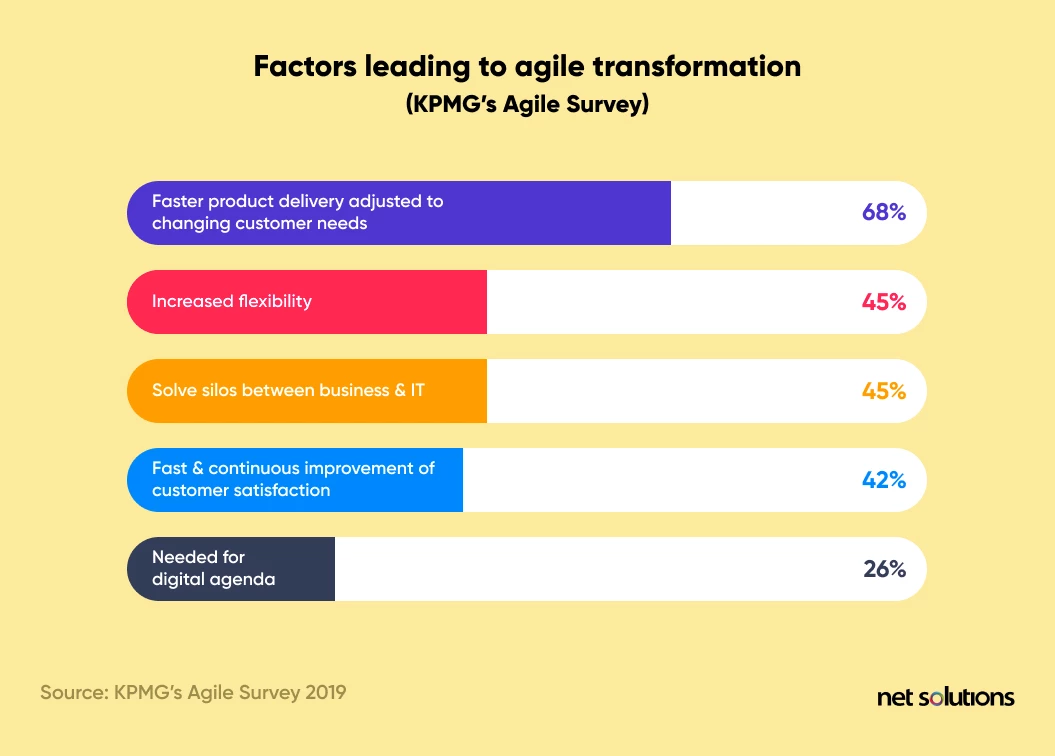
Once you understand the 10 reasons mentioned above on why agile transformations fail, you should keep the following in mind to truly understand how to transform organizations to agile:
1. Collaborative endeavor in processes
Before you think of how to start the agile transformation, you must understand that it has to be a path of joint involvement. Teams will build the foundation of the agile transformation process, and organizations will have to rework every step. There has to be end-to-end agility with all departments involved in the process – isolation is a strict no-no. It is wise to build holistic goals considering all departments’ roles, keeping the significant picture transformation in mind. Shared ownership is the key. Organizations should prefer open communication over mere hierarchy. Forbes describes the hierarchical mindset vs. the agile mindset in a straightforward yet effective manner.
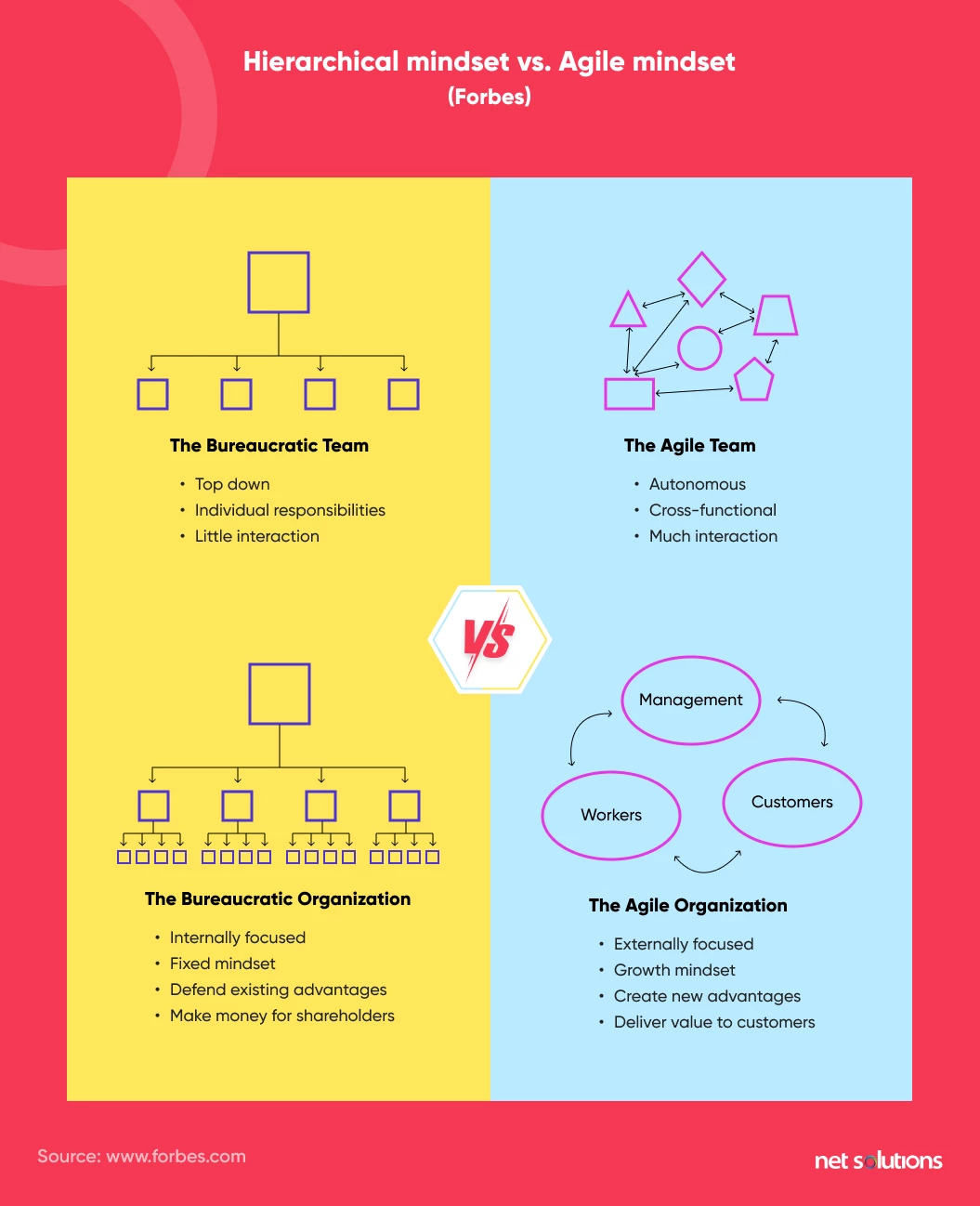
2. Agile as a culture
The agile transformation needs to become a part of the total organizational culture. It has to be fully embedded in the operational teams’ mindset, with everyone investing their time and energy into the agile retrospectives. Leadership has to be proactively supportive and remove obstacles rather than hamper teamwork. Virtual collaborations are good, usually efficient, and faster to implement, thus leading to faster results.
Before you reorganize entirely, create a culture and collaborative base. It should be done if an organization has to modify team performance measures, compensation benefits, and role definitions. McKinsey has reported saying that firms and units implementing Agile do better financially than those that don’t.
3. Clarity on deliverables
Teams should focus on delivering stated and specific value to customers. Don’t just focus on meaningless milestones; be more focused on value addition and the product or service. Reorder your organization or workflows if needed. While doing so, you should adopt a strategy that lets you and your teams progress per clearly stated business goals—lucid statements of goals aid work efficiency. Provide your teams with the right tools, and teach an atmosphere of trust, not fear.
4. Mindset is the key
An organization needs an experimental mindset backed by the willingness to be creative and innovative. You must be willing to snap out of old approaches or the so-called “tried & tested” methods. All this needs to be supported by an accurate performance measurement; without measuring success, you won’t know how the approach fares. Every organization will decide how to measure the success of the agile transformation by its specific set parameters. Incremental step adoption will ensure your organization will experience its agile transformation success story. It helps to have creative mindsets rather than reactive ones.
5. Break the technological barriers
Technology often becomes the primary bottleneck or impediment to enhanced speed and quality. New product development improves when it removes traditional, non-cloud product development methods. Embrace modern technology, and build a base for responding to customer needs at a speed corresponding to their evolving needs & demands. Both product quality & on-time delivery guarantee agile transformation success. Leveraging technology is a big step in the process of agile transformation.
McKinsey describes the path to agile transformation in a very lucid manner:
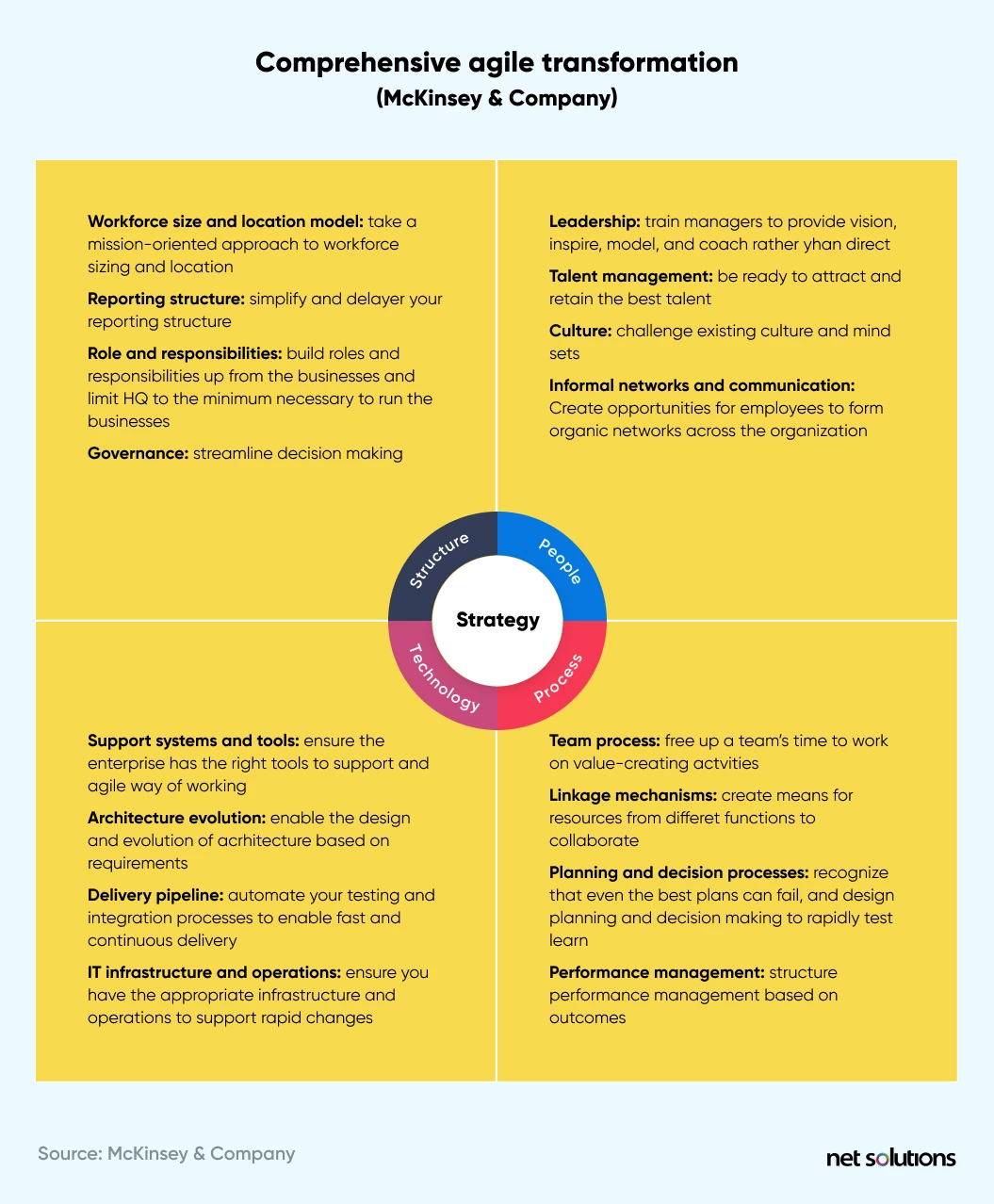
McKinsey explains in its analysis that “transformations emphasizing both strengths and challenges are three times more likely to succeed.”
Agile transformation success stories – some examples
Netflix and its Cultural Evolution
Netflix aimed to foster innovative thinking and high performance in their organization. And the management decided to bring in a culture of freedom, high-value performance, and responsibility by treating employees like grownups.
Netflix achieved its agile transformation objective in the following ways:
- Assigning trust in responsible behavior and employee judgment creates space for independence.
- By substituting annual reviews and performance improvement plans with frequent and open conversations with team leads as an organic part of daily work.
Result:
It boosted employees’ independence and decision-making power through less organizational complexity and bureaucracy, leading to faster feedback, iterative changes, and cross-collaboration, paving the way for an agile transformation.
Bosch and its leadership role
Bosch was able to see the need to be more innovative and agile. The transformation process for the company started in 2018. Initially, the company adopted a dual organization status where the business ran as usual. Then some parts of the company also began operating on agile processes.
However, this approach was unsuccessful, and the company started from the very beginning – this time addressing leadership roles first. They worked on status reports, plans, and priorities and identified the blockers that every sector might have.
Leadership sought fast feedback, encouraged collaboration, and addressed the organization’s backlog.
Vanguard & its effective strategy
Vanguard’s strategy started in 2007 when it adopted the Scrum framework. About 6-7 years later, most of their teams switched to Kanban. They chose to do so for the speed of the learning process, the quick feedback processes, and the big picture view of the entire flow, end-to-end.
The company worked to remove its challenges of understanding workflows and customer profiles. Through the agile transformation process, multiple workflows got streamlined. They introduced specific policies for workflows and achieved consistency in work processes. It worked for them to imbibe a simple and effective agile process methodology.
FAQs
An organization should first know the “why” behind the transformation process and then pose questions regarding these basics:
- Challenges to be overcome
- Willingness to restructure
- Degree of cultural change
- Communication strategy
- Framework being used
- Tech stack & talent available
- Process of education of teams for the transformation
- Measurement of progress
It would be tempting to put it as weeks, months, or a few years. The reality, however, is that – an agile transformation never ends because the market dynamics keep evolving, and changes keep happening. There is always something new to deal with, strategize for and iterate. For as long as a company addresses its “what” (product, systems, processes), the “how” (methodology, iteration, innovation) will be critical. It means a constant improvement to stay ahead of the competition.
Change in the work culture is the first indicator of a transformation. Efficiency and speed follow. A significant part of the agile transformation will be the focus on customer satisfaction which related agile metrics can measure. Agile transformation-infused organizations will also reflect more incredible energy & ideas, more imagination, greater creativity, and more innovative approaches. Finally, all this will translate into a business’s overall growth in product base, customer satisfaction, and company revenues.




